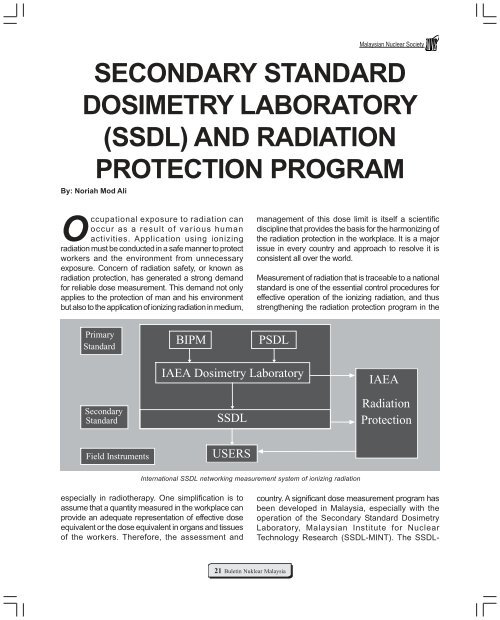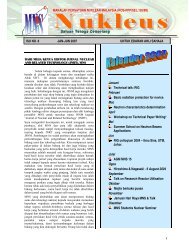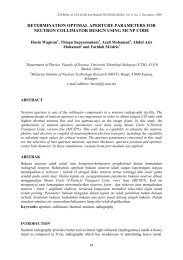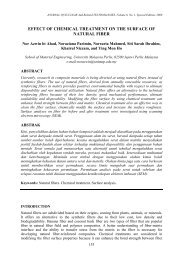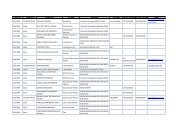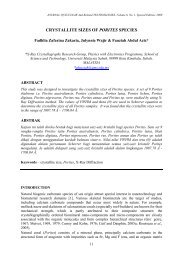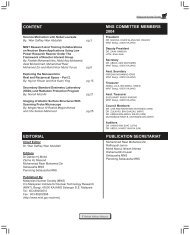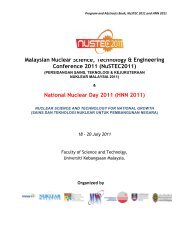secondary standard dosimetry laboratory (ssdl) - Nuklearmalaysia.org
secondary standard dosimetry laboratory (ssdl) - Nuklearmalaysia.org
secondary standard dosimetry laboratory (ssdl) - Nuklearmalaysia.org
- No tags were found...
Create successful ePaper yourself
Turn your PDF publications into a flip-book with our unique Google optimized e-Paper software.
Malaysian Nuclear SocietySECONDARY STANDARDDOSIMETRY LABORATORY(SSDL) AND RADIATIONPROTECTION PROGRAMBy: Noriah Mod AliOccupational exposure to radiation canoccur as a result of various humanactivities. Application using ionizingradiation must be conducted in a safe manner to protectworkers and the environment from unnecessaryexposure. Concern of radiation safety, or known asradiation protection, has generated a strong demandfor reliable dose measurement. This demand not onlyapplies to the protection of man and his environmentbut also to the application of ionizing radiation in medium,management of this dose limit is itself a scientificdiscipline that provides the basis for the harmonizing ofthe radiation protection in the workplace. It is a majorissue in every country and approach to resolve it isconsistent all over the world.Measurement of radiation that is traceable to a national<strong>standard</strong> is one of the essential control procedures foreffective operation of the ionizing radiation, and thusstrengthening the radiation protection program in theInternational SSDL networking measurement system of ionizing radiationespecially in radiotherapy. One simplification is toassume that a quantity measured in the workplace canprovide an adequate representation of effective doseequivalent or the dose equivalent in <strong>org</strong>ans and tissuesof the workers. Therefore, the assessment andcountry. A significant dose measurement program hasbeen developed in Malaysia, especially with theoperation of the Secondary Standard DosimetryLaboratory, Malaysian Institute for NuclearTechnology Research (SSDL-MINT). The SSDL-21 Buletin Nuklear Malaysia
Malaysian Nuclear SocietyMINT was established in 1980. It was designated bythe Malaysian Government as the national authority toundertake the duties of improving accuracy in radiation<strong>dosimetry</strong> and providing necessary link in the traceabilityof radiation <strong>dosimetry</strong> to national/international <strong>standard</strong>sfor users within the country. SSDL-MINT is thusequipped with <strong>secondary</strong> <strong>standard</strong> equipments, whichare traceable to primary <strong>standard</strong>s dosimeterlaboratories (PSDLs). Within this scope, allmeasurements are linked and traceable to theinternational <strong>standard</strong> at the International Bureau ofWeights and Measures (BIPM).SSDL-MINT is a member of the IAEA/WHO SSDLNetwork, which is established as a results of concertedeffort by the International Atomic Energy Agency (IAEA)and the World Health Organization (WHO) to provide aforum and economic solution for the dissemination ofproper dose measurement and thus strengthens theradiation <strong>dosimetry</strong> coherence worldwide. Thirty yearsafter its foundation, this network comprises 80 memberlaboratories, many of which are located in the developingareas of the world. The network is supported by fifteennational primary <strong>standard</strong> laboratories and a number ofinternational bodies and committees.The international measurement system of ionizingradiation where traceability of field instrument (users)to primary <strong>standard</strong>s is generated through the networkof SSDLs. The inner box shows the steps wheretraceable calibration is accomplished, where the IAEA<strong>dosimetry</strong> <strong>laboratory</strong> is the central <strong>laboratory</strong> of theSSDL network. By providing calibration and referenceirradiation to the agency radiation monitoring andprotection service, traceability can be generated downto the level of personal and area monitoring in memberstates.SSDL- MINTSince its establishment, SSDL-MINT has maintainedand applied state of art of dosimetric equipment, whichincludes supply of personal and area dosimeter toradiation workers and calibration of all the radiationmeasuring equipment. These services provide the basisof the harmonization of the occupational radiationmonitoring in Malaysia. This also includes calibration ofworking <strong>standard</strong> ionization chamber used to monitorthe output from the radiotherapy facilities. SSDL-MINTis also responsible to supply routine dosimeters suchas ceric-cerous dosimeters for gamma industrial plantsin the country.The radiation <strong>standard</strong>s and calibration <strong>laboratory</strong> ofSSDL-MINT is an up-to-date facility for providing highqualitycalibration and irradiations, consistent withnational <strong>standard</strong>s in support of radiation protection andexternal <strong>dosimetry</strong> programs. The <strong>laboratory</strong> isequipped with a wide range of radiation sources,including Cobalt-60, Caesium-137, Americium-241,Strontium-90/Ytrrium-90, Thallium-204, Promethium-147and Americium-241/Beryllium. The <strong>laboratory</strong> is alsoequipped with many kinds of <strong>secondary</strong> <strong>standard</strong>dosimeters and is manned by skilled staff with expertiseand experience in radiation measurement, <strong>dosimetry</strong>and calibration. The <strong>laboratory</strong> has a 320 kV constantpotential X-ray generator that can generate X-raybeams over an effective energy range of 20 keV to 250keV using the beam code technique as specified bythe ISO 4037. SSDL-MINT also provides training andadvice to the users of ionizing radiation on up-to-datemeasurement procedures and techniques.Accurate radiation measurement at SSDL-MINT relieson <strong>standard</strong> dosimeter and procedure of measuringthe dose. In most cases the <strong>standard</strong>ization of radiationmeasurements involves a link of traceability from theworking measurement system by transfer <strong>standard</strong>s tosome kind of reference <strong>standard</strong>, ideally to a national<strong>standard</strong> ionization chamber.DOSIMETRIC CONTROL OF A PROCESSThe scope of SSDL may be quite broad in somecountries and restricted in other countries, dependingon national needs. SSDL-MINT had been responsiblefor reliable and traceable dose interpretation for allradiation workers and workplaces in Malaysia. This isin line with the objective of the radiation protectionprogram laid by the Atomic Energy Licensing Board ofMalaysia (AELB) through the Atomic Energy LicensingAct 1984 (Act 304) to ensure the safe use of atomicenergy activities in MalaysiaDosimeters and irradiationfacilities at SSDL-MINTThe accuracy and precision of the <strong>dosimetry</strong>system adopted by SSDL-MINT are checked andverified through incorporation of intensive quality22 Buletin Nuklear Malaysia
Malaysian Nuclear Societyassurance programs covering internal andinternational inter-comparison programs. Theseprograms help SSDL-MINT maintains the national<strong>standard</strong>s, verifies the application of properprotocols and monitor their calibration/evaluationprocedures. The internal program includes:• routine check source measurement on thereference dosimeter . The deviation between thecurrent value to <strong>standard</strong> value is of main interestfor chamber stability and is maintained within ± 1%.• measurement of beam/output of the irradiator.• quality test of the personal dosimeter response.• updating staff training.The external inter-comparison includes measurementassurance tests through the IAEA/WHO doseassurance service. There is also the inter-comparisonof <strong>standard</strong>s and techniques with other SSDLs andthe calibration of SSDL-MINT reference dosimeteragainst the PSDL. This includes:• IAEA/WHO TLD postal service.• IAEA International Dose Assurance Service (IDAS).• comparison with other reputable internationalinstitutes.Since 1985, the results obtained from these programsare very encouraging (i.e. 10% for IDAS and ± 3.5% forTLD postal service) and provided us with greaterconfidence in the accuracy of our <strong>dosimetry</strong> system.(a) Personal Dosimeters(b) Secondary Standard dosimeters(c) Co-60 Teletherapy Facility(d) X ray irradiation facilities23 Buletin Nuklear Malaysia
Malaysian Nuclear SocietyISO CERTIFICATIONThe objectives of <strong>dosimetry</strong> activities are oftenregarded as being limited to the measurement ofdoses, but its function is much more extensive. It mustdemonstrate that there has not been any unexpecteddeterioration of the working conditions. To maintaina recognizable trace to the international <strong>standard</strong>,SSDL-MINT is preparing a comprehensive QualityAssurance Program for all <strong>dosimetry</strong> services.Several strategies has been laid down intoSSDL-MINT practice which includes planned andsystematic actions that are necessary to provideadequate confidence in the results of the <strong>dosimetry</strong>program. The main approach of SSDL-MINT is theintegration into a:• Quality Management System (QMS) which isdeveloped with objective to obtain the ISO 9001certification for the personal <strong>dosimetry</strong> service.• Competent Calibration <strong>laboratory</strong> through theaccreditation ISO/IEC 17025 for the calibrationservice.It started with a compilation of necessary documentsthat had been initiated in early 2001. Since then, allwork is based on the policy and procedures asdocumented in the Quality Manual and QualityProcedures. Work instructions are written in layman’sterms, easier understood by process operators andsupervisors; and as result also easier to integrate aspart of the day to day operations. The systemdocumentation is controlled, with each documentcontaining a history of revisions, a distribution list anda signature page duly signed by SSDL-MINTauthorities.Great efforts has been undertaken in training of staffto familiarize themselves with the ISO 9001 and ISO/IEC 17025 requirements. Several audits have beenconducted to continuously review the critical processpoints, corrective action and outcomes. Third partyaudit for the purpose of registration was held andcertification was obtained in February 2002 for theISO 9001 and in July 2004 for the ISO/IEC 17025.This certification and accreditation reaffirm the highquality of measurements performed by SSDL-MINTand instill confidence among its customers on thework that it carries out.SUMMARYEstablishment of the existing <strong>dosimetry</strong> system atSSDL-MINT is an important milestone in thedevelopment of the irradiation industries in Malaysia.The achievement of traceability to recognizemeasurement <strong>standard</strong>s for ionizing radiationpossesses the basis for harmonized radiationprotection in the workplace. Such traceability can addconfidence on the protection of workers, the publicand the environment. It will also strengthen and retainpublic confidence in our radiation protectionframework.Additional efforts of SSDL-MINT to obtain certificationon ISO 9002 and ISO/IEC 17025 for the personal<strong>dosimetry</strong> and calibration service respectively willgreatly enhance the confidence and integrity of thecurrent practice.FURTHER READING1. Laws of Malaysia (Act 304) Atomic EnergyLicensing Act 1984.2. Secondary Standard Dosimetry Laboratories:Development and Trends, 1985.3. Secondary Standard Dosimetry LaboratoryNetwork Charter, 1999.4. Secondary Standard Dosimetry LaboratoryNewsletter, 2000.5. Noriah, M.A. Implementation of A Quality Systembased on ISO 9001 Requirement in MalaysiaNational Dosimetry Services For MonitoringExternal Radiation Exposure (IAEA-CN-107/13).International Conference on NationalInfrastructures for Radiation safety: TowardsEffective and Sustainable Systems, Morocco,September 2003.6. Noriah Mod Ali. Management of RadiationProtection Program by Personal Dosimetry.Nuclear Bulletin of Malaysia, Vol. 10,July- December 2003~~ ºº ~~24 Buletin Nuklear Malaysia


